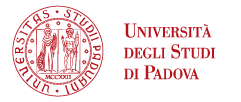Advanced Drug Delivery
The Team
Modern approaches aimed at improving the efficacy or personalizing therapies are based on the general concept of concentrating the proper therapeutic agent to its biological target, taking advantages of function or receptor targeted principles. In this context, colloidal and nanoparticle-based solutions offer unrivalled opportunities due to their ability to incorporate high amounts of active payload while protecting it from a potentially harmful environment. In addition, their multifunctionability potential, in principle allows to incorporate targeting and/or differently responsive elements, and thus to modulate the mechanism of action.
The Advanced Drug Delivery Team is involved in a multidisciplinary research on essential areas in the pharmaceutical technology: Development of novel Drug delivery systems, Formulation studies, Pharmaceutical Material Development, Nanoscience Technology, Bioconjugation of Biologics and Polymers, early stage ADME studies, Interface properties of colloidal drug nanocarriers.
| |
 | Margherita Morpurgo Department of Pharmaceutical and Pharmacological Sciences, University of Padova, via F. Marzolo 5, 35131 Padova -Italy. via F. Marzolo 5, 35131 Padova -Italy Phone: +39049827-5330 e-mail: margherita.morpurgo@unipd.it https://www.researchgate.net/profile/Margherita_Morpurgo https://www.linkedin.com/in/margherita-morpurgo-085b8625 skype: morpil2 |
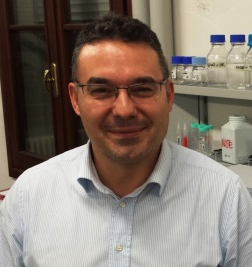 | Stefano Salmaso Department of Pharmaceutical and Pharmacological Sciences, University of Padova, via F. Marzolo 5, 35131 Padova -Italy Phone: +390498271602, e-mail: stefano.salmaso@unipd.it https://www.researchgate.net/profile/Stefano_Salmaso?ev=hdr_xprf https://www.linkedin.com/profile/view?id=25945414&trk=nav_responsive_tab_profile |
Margherita Morpurgo, PhD
Aggregate Professor at the Medical School, Pharmaceutical and Pharmacological Department,, Pharmaceutical Technology area.
Rector Delegate for technology Transfer in the Life Sciences
Co-founder and CSO of ANANAS Nanotech, a University Spin-off dedicated at developing avidin-based nanoparticles for in vitro diagnostics and drug delivery. ANANAS nanotech received several National and International recognitions ( 2006 National Innovation (PNI) Price and the 2007 International Nanochallenge award).
Visiting professor at Guangzhou University, China in 2012
Contact
Department of Pharmaceutical and Pharmacological Sciences, University of Padova, via F. Marzolo 5, 35131 Padova -Italy.
Phone: +39049827-5330
e-mail: margherita.morpurgo@unipd.it
https://www.researchgate.net/profile/Margherita_Morpurgo
https://www.linkedin.com/in/margherita-morpurgo-085b8625
skype: morpil2
Research
- Organic and inorganic micro and nanoassemblies as engineered delivery systems for biotechnological and synthetic drug
- Nanobased solutions for high performance biosensors and diagnostic systems.
- Random Screening technologies for the identification of specific tissue binding ligands for diagnostics and delivery purpose
- Quantitative approaches for biosensor Surface functionalization
Drug Delivery projects
The Avidin Nucleic Acids NanoASemblies (ANANAS) Platform
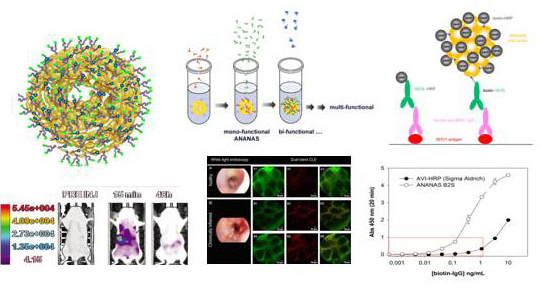
This platform was invented and developed in our laboratory. The ANANAS are soft biocompatible and biodegradabole poly-avidin nanoparticles (NP) obtained through a proprietary
Nature-guided process of assembly, which guarantees stoichiometric composition and performance reproducibility. They are biocompatible polymers of avidin with superior performance, applicable in both drug delivery and immunodiagnostics. The NPs are multifunctionalizable in one pot reactions, they have colloidal stability in physiological buffer which permits several applications in nanomedicine. The ANANAS technology is patented worldwide and the lab is involved in investigatingits use in different biomedical applications.[1-4]
1. Casarin E, Lucchese L, Facchin S, Grazioli S, Realdon N, Brocchi E, et al. (In press) A new ELISA using the ANANAS technology showing high sensitivity to diagnose of the bovine Rhinotracheitis Diagnosis from individual sera to pooled milk. Plos One.
2. Buda A, Facchin S, Dassie E, Casarin E, Jepson MA, Neumann H, et al. (2015) Detection of a fluorescent-labeled avidin-nucleic acid nanoassembly by confocal laser endomicroscopy in the microvasculature of chronically inflamed intestinal mucosa. International Journal of Nanomedicine 10: 399-408.
3. Bigini P, Previdi S, Casarin E, Silvestri D, Violatto MB, Facchin S, et al. (2014) In Vivo Fate of Avidin-Nucleic Acid Nanoassemblies as Multifunctional Diagnostic Tools. Acs Nano 8: 175-187.
4. Morpurgo M, Facchin S, Pignatto M, Silvestri D, Casarin E, Realdon N (2012) Characterization of Multifunctional Nanosystems Based on the Avidin-Nucleic Acid Interaction As Signal Enhancers in Immuno-Detection. Analytical Chemistry 84: 3433-3439.
Sol-Gel Silica for the Stabilization and controlled release of bioactive compounds
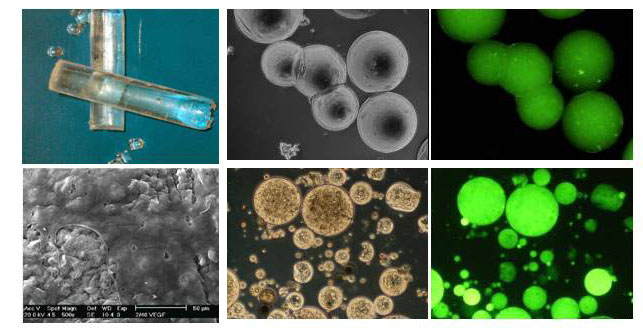
Sol-gel silica is an inorganic polymer with high potentials in biomedicine. It is easy to produce from low cost precursors and it is highly versatile so that materials useful for multiple applications can be envisaged.
Depending on the polymer porosity, internal organization and composition, sol-gel silica based materials capable of improving the dissolution of poorly soluble drugs or matrices for the sustained release of highly soluble and unstable drugs have been described. Further advantage is that silica and its degradation products are well tolerated by the human body: parenteral administration of different types of synthetic silica polymers has been described in the literature and high tolerability was demonstrated. The polymer is eroded into silicic acid (a compound that is abundant in mineral water) and it is then eliminated through the kidneys. Only minor and reversible toxicity was shown upon large dose administration. Depending on the polymerising conditions, dry or wet silica based polymers with nano- meso- o micro-porosity are obtained.
Among the biomedical applications investigated in the lab are the controlled release of low molecular weight, polymer and protein and nucleic acid based drugs.[5-8]
5. Brigo L, Scomparin E, Galuppo M, Capurso G, Ferlin MG, Bello V, et al. (2016) Mesoporous silica microspheres as drug dissolution enhancers: influence of drug and matrix chemistry on functionality and stability. Materials Science & Engineering C 59: 585–593.
6. Morpurgo M, Mozzo A, Ferracini C, Pignatto M, Realdon N (2011) Wet sol-gel silica microspheres for the sustained release of human growth hormone. In: Morris RE, editor. The Sol-Gel Process: Uniformity, Polymers & Applications. Hauppauge-NY: Nova Science. pp. 703-720.
7. Cini R, Defazio S, Tamasi G, Casolaro M, Messori L, Casini A, et al. (2007) Fac-{Ru (CO) 3} 2+-core complexes and design of metal-based drugs. Synthesis, structure, and reactivity of Ru-thiazole derivative with serum proteins and absorption-release studies with acryloyl and silica hydrogels as carriers in physiological media. Inorganic chemistry 46: 79-92.
8. Teoli D, Parisi L, Realdon N, Guglielmi M, Rosato A, Morpurgo M (2006) Wet sol-gel derived silica for controlled release of proteins. Journal of Controlled Release 116: 295-303.
Awards and Prices
1999: “G. Salvatore” Price, awarded to Italian researchers to carry specific research projects in foreign institutions.
2006: “Premio Nazionale Innovazione” (National Price for Innovation)
2007: “International Nanochallenge Price”
2010: Selected to represent the Italian “innovators” at the Shanghai Universal Expo.
Teaching activities
School of Medicine , Pharmacy and Pharmaceutical Chemistry Degrees:
Formulation and Analysis Industrial Pharmaceutical Products
Medical Device Technologies.
Graduate school in Molecular Sciences:
Non viral gene delivery vectors; Nanotechnology for medicine; Nanotechnology in drug formulation.
Stefano Salmaso, PhD
Associate Professor at the Medical School, Department of Pharmaceutical and Pharmacological Sciences.
Contact
Department of Pharmaceutical and Pharmacological Sciences, University of Padova,
via F. Marzolo 5, 35131 Padova -Italy.
Phone: +390498271602,
e-mail: stefano.salmaso@unipd.it
https://www.researchgate.net/profile/Stefano_Salmaso?ev=hdr_xprf
https://www.linkedin.com/profile/view?id=25945414&trk=nav_responsive_tab_profile
http://www.nanopharmanet.it/stefanosalmaso
Since 2014 Stefano Salmaso is associate professor at the Department of Pharmaceutical and Pharmacological Sciences of the University of Padova.
He received his Ph.D. in “Pharmaceutical Sciences” in 2004 from the University of Padova. He completed his training in international awarded research groups at the School of Pharmacy of the University of Paris-Sud XI, at I.B.M.C Center of the University of Strasbourg, and at Centre for Innovative Biotechnologies of the University of Padova.
He held positions as assistant professor at the University of Padova (2004-2014) and as associate scientist at Northeastern University (Boston-USA, 2005 and 2008) where he developed novel responsive nanocarriers for drug delivery to the tumor and the brain and innovative immunoliposomes for selective activation of dendritic cells.
In 2009 he was recipient of a three-years grant from the European Commission in the framework of the FP VII (NanoSCI ERAnet) for the development of responsive polymersomes for the delivery of siRNA to silence key proteins in the progression of cancer in collaboration with the University of Nottingham and Principe Felipe Research Center in Valencia.
He has co-founded the “Nanopharmanet”, the Italian Network of scientists operating in the Pharmaceutical Nanomedicine and Nanotechnology fields.
He has authored 51 papers in high ranking international journals, more than 90 conference communications, 3 book chapters and 3 international patents.
His research activity is funded by public institutions (University of Padova, European Commission, European Social Fund) and private companies (MedImmune/Astrazeneca, Pharmeste, Prigen, Fidia).
Current research
Anticancer drugs and biopharmaceutics possess high pharmacological activity but suffer from toxicity, poor biopharmaceutical features and site-selectivity, which makes their pharmaceutical development a challenge. The generation of innovative nanotechnological drug delivery systems provide opportunities to balance the drug drawbacks and ensure for the site-selective delivery and controlled release at target sites in the body.
Stefano Salmaso has designed and developed a variety of colloidal systems (micelles, liposomes and polymersomes, polymeric and metallic nanoparticles) by combining responsive materials, functional and targeting agents for the local delivery and controlled release of anticancer drugs and macromolecules (peptide, proteins, siRNA). His major contribution in the drug delivery field lays in the understanding of the interfacing requirements to generate efficient colloidal drug carriers.
Areas of interest:
- nanotechnology for drug and protein delivery
- “smart” responsive nanocarriers
- self-assembling technologies
- metal based nanoparticles for drug delivery and external stimuli based therapy
- environmentally sensitive micelles, vescicles and liposomes for anticancer drug, protein, siRNA delivery.
Project highlights
Development of metal nanovectors for cancer multimodal targeting.
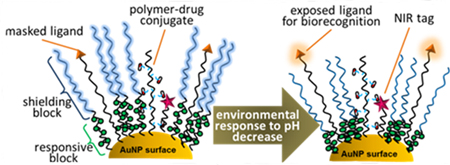
Gold nanoparticles (AuNP) have raised lot of interest due to their application as contrast agents in CT imaging, X-ray and ultrasound sensitizers for tumour treatment. AuNPs are under development by combining multifunctional components to yield ehanced site-selectivity in the tumor tissue. Gold nanoparticles are used as anticancer drug carriers, as sonosensitizers and radiotherapy sensitizers in novel applications.
Environmental stimuli responsive micelles, liposomes, polymeric vesicles.
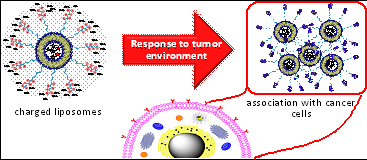
Vesicular nanosystems assembled with responsive materials and targeting agents for the controlled release of anticancer drugs, proteins with immunostimolating propersties, siRNA for silencing proteins involved in cancer development are under development. These projects aim to generate carriers with finely controlled interfacial properties by a proper design of the components and the assembling strategies. The aim is to understand how the interfacial features of the carriers can be leveraged for the spatial and temporal control of the interaction with cells/tissues, the drug release, the intracellular fate. Nanocarriers are under investigation for the parenteral or local administration of different class of therapeutic molecules.
Formulation of proteins by physical assembly with amphiphilic polymers.
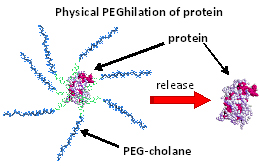
With the aim to efficiently deliver proteins with biological activity and ameliorate their pharmacokinetic profile, colloidal systems obtained by physically assembling amphiphilic polymers with cytokines are under development. This formulation approach was shown to significantly enhance the stability of the protein and allow for avoiding the chemical manipulation of the protein structure, which is detrimental for the therapeutic activity.

